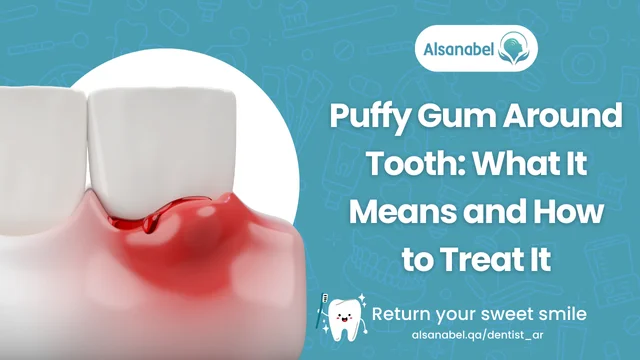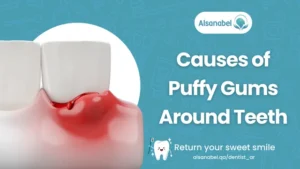
Having a puffy gum around tooth can be an alarming and uncomfortable experience. This condition is often accompanied by redness, tenderness, and sometimes even pain. In many cases, swollen gums near teeth may indicate an underlying oral health issue that requires attention. Understanding the causes of puffy gums and learning how to relieve puffy gums can help prevent complications such as infections, gum disease, or even tooth loss.
In this comprehensive guide, we will explore the most common reasons for puffy gum around tooth, the potential risks associated with gum inflammation, and effective treatment options, including both professional dental care and home remedies.
Causes of Puffy Gums Around Teeth
Gum swelling can occur due to several reasons, ranging from mild irritation to more serious dental problems. Identifying the causes of puffy gums early can help prevent the condition from worsening.

1. Poor Oral Hygiene
One of the most common causes of puffy gums is inadequate oral hygiene. When plaque and food particles accumulate along the gum line, bacteria multiply, leading to inflammation and swelling.
- Failing to brush and floss regularly allows plaque to harden into tartar, which irritates the gums.
- Bacteria in plaque release toxins that cause gum irritation, resulting in a puffy gum around tooth.
2. Gingivitis (Early Stage of Gum Disease)
Gingivitis is a mild but reversible form of gum disease that causes redness, swelling, and bleeding of the gums.
- If swollen gums near teeth persist, it may indicate that gingivitis is progressing.
- Gingivitis is usually painless, which makes it easy to overlook until symptoms worsen.
3. Periodontitis (Advanced Gum Disease)
If gingivitis is left untreated, it can develop into periodontitis, a more severe form of gum disease that damages the gums and supporting bone structure.
- Deep pockets form between the teeth and gums, trapping bacteria and worsening inflammation.
- Periodontitis can cause gum recession, loose teeth, and even tooth loss.
4. Food Trapped Between Teeth
Food particles, especially hard or fibrous foods like popcorn, nuts, or meat, can get stuck between the teeth and irritate the gums, leading to localized swelling.
- If puffy gum around tooth occurs after eating, trapped food may be the culprit.
- Flossing and rinsing with water can help remove the debris and reduce swelling.
5. Dental Abscess (Infection in the Tooth or Gums)
A puffy gum around tooth may also indicate a dental abscess, which is a pocket of pus caused by a bacterial infection.
- Abscesses develop due to severe tooth decay, gum infections, or trauma.
- Symptoms include severe pain, swelling, pus discharge, and sometimes fever.
- A dental abscess requires immediate professional treatment, as the infection can spread.
6. Hormonal Changes
Hormonal fluctuations during pregnancy, menstruation, or menopause can cause swollen gums near teeth.
- Increased blood flow to the gums makes them more sensitive and prone to swelling.
- Maintaining a consistent oral hygiene routine is essential during hormonal changes.
7. Ill-Fitting Dental Work or Braces
Dental restorations like crowns, bridges, or braces that do not fit properly can irritate the gums and cause localized inflammation.
- Constant friction between the dental appliance and the gum tissue can lead to a puffy gum around tooth.
- A dentist can adjust or replace the restoration to resolve the issue.
How to Relieve Puffy Gums and Reduce Swelling
If you are experiencing swollen gums near teeth, there are several ways to reduce inflammation and relieve discomfort. These treatments include both professional dental care and how to relieve puffy gums using home remedies.
1. Professional Treatments for Puffy Gums
For persistent gum swelling, professional dental care is the most effective solution.
- Dental Cleaning: Scaling and root planing remove plaque and tartar buildup from below the gumline, preventing further inflammation.
- Antibiotics: If an infection is present, your dentist may prescribe antibiotics in the form of oral medication, gels, or mouth rinses.
- Drainage of Abscesses: If the swelling is caused by a dental abscess, the dentist will drain the pus and treat the infection.
- Surgical Procedures: In cases of severe gum disease, surgical intervention may be required to restore gum health.
2. Home Remedies for Puffy Gums
If you are looking for how to relieve puffy gums at home, several natural remedies can help reduce inflammation and promote healing.
1. Warm Salt Water Rinse
A saltwater rinse is an excellent DIY remedy for gum swelling.
- How to Use It:
- Mix ½ teaspoon of salt in a glass of warm water.
- Swish it around your mouth for 30 seconds, then spit it out.
- Repeat twice daily to reduce swelling and kill bacteria.
2. Cold Compress for Immediate Relief
A cold compress helps reduce swelling and numb discomfort.
- How to Use It:
- Wrap ice cubes in a clean cloth.
- Apply it to the affected area for 10–15 minutes.
- Repeat every few hours as needed.
3. Aloe Vera Gel
Many people ask, does aloe vera help swollen gums? The answer is yes! Aloe vera has natural antibacterial and anti-inflammatory properties.
- How to Use It:
- Apply fresh aloe vera gel directly to the swollen gums.
- Leave it on for 10 minutes, then rinse your mouth.
- Use twice daily for relief.
4. Green Tea Mouth Rinse
If you’re wondering, how does green tea benefit swollen gums, it contains antioxidants that help reduce inflammation.
- How to Use It:
- Brew a cup of green tea, let it cool, and use it as a mouth rinse.
- Drink it regularly to improve gum health.
5. Essential Oils for Gum Health
Certain essential oils have antimicrobial and anti-inflammatory properties, making them useful for gum swelling.
- Best Essential Oils for Swollen Gums:
- Clove Oil: Natural pain relief and antibacterial.
- Tea Tree Oil: Fights bacteria and reduces inflammation.
- Peppermint Oil: Provides a cooling sensation and freshens breath.
- How to Use It:
- Mix a few drops of essential oil with a teaspoon of coconut oil.
- Apply it to the swollen gum area.
- Repeat once daily for best results.
Frequently Asked Questions About Puffy Gums Around Teeth

1. Why is my gum puffy around one tooth?
A puffy gum around tooth can result from plaque buildup, food debris, gingivitis, or an underlying infection.
2. Is a puffy gum around a tooth a sign of infection?
Yes, persistent swelling accompanied by pain, pus, or fever may indicate a bacterial infection that requires professional treatment.
3. Can a puffy gum indicate a dental abscess?
Yes, if the swelling is accompanied by severe pain, pus, or a bad taste in the mouth, it could be a dental abscess, which needs immediate dental attention.
4. How do I reduce swelling in my gums quickly?
To quickly reduce swelling, use a cold compress, rinse with salt water, and apply aloe vera gel or clove oil for relief.
5. What home remedies help with puffy gums around teeth?
Effective home remedies include warm salt water rinses, aloe vera gel, green tea, essential oils, and cold compresses to reduce inflammation and promote healing.
Having a puffy gum around tooth can be concerning, but identifying the causes of puffy gums early and knowing how to relieve puffy gums can prevent further complications. Whether through improved oral hygiene, home remedies, or professional dental care, taking proactive steps ensures better gum health and prevents long-term dental problems. If swelling persists, visiting a dentist for proper diagnosis and treatment is always the best course of action.
